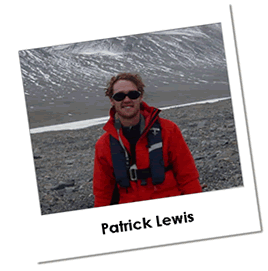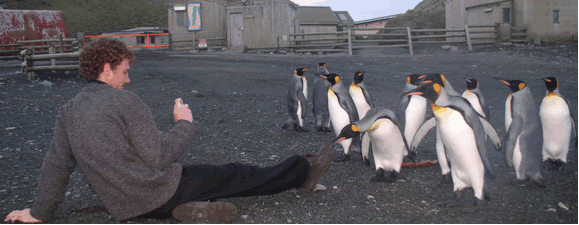
| Home > The Scientists > Patrick Lewis | |||||||||||||||
As the ocean was out of reach to him while growing up, the farm dam was the only “sea” Pat knew, and he made the most of it. “I’d frequently spend the days catching perch and teasing catfish as they guarded their nests of eggs. For my biology ‘fix’ I’d content myself with poking around under logs and rocks looking for creepy crawlies and snakes. I was always fascinated with wild things.” Pat’s interest took a logical progression towards snakes and what began as a modest collection of snakeskins turned into an obsession with the idea of keeping a four-foot long pet carpet snake. “I managed to sneak the beast into an aquarium in my room, but it disappeared and I was never quite sure if it had escaped or if my mother had ordered my father to remove it!” Pat got his first ‘real shot’ at being a biologist in Year 11 when his teacher gave him the opportunity to work with the Queensland Museum. “A few truculent students (and as a teenager I was amongst them) were dragged to the coast to participate in a project investigating the rate at which dead green turtles were washed ashore in Moreton Bay, and the incidence of boat strikes amongst them,” Pat reminisces. The project involved exploring mangrove swamps and wading through waist-deep mud looking for turtle skeletons, but as he had “a bit of a crush” on his biology teacher, for Pat it was worth getting a bit muddy. The experience he gained working with the museum and participating in a field research project was invaluable and set Pat further on the path towards biology. “Although I enjoyed the occasion very much, I never actually saw a live sea-turtle until a reporter from the courier mail came to interview us and brought along a turtle borrowed from Seaworld to add some interest to the photographs!” After high school in Queensland, Pat moved to Hobart to start a Bachelor of Science degree at the University of Tasmania. He majored in Marine, Freshwater and Antarctic Biology, and began to realise the variety of opportunities for Tasmanian scientists to access the Southern Ocean and Antarctica. “Although I had never imagined this as a career path, the completion of my BSc saw me signing up for another year of study at the Institution of Antarctic and Southern Ocean Studies (IASOS) – this time it was for a Bachelor of Antarctic Studies with a research Honours degree included.” After exploring a variety of projects for Honours degree, Pat settled on a topic that investigated the extent to which human activities transport invasive marine species into the sub-Antarctic islands and Antarctica.
“During my Honours year I investigated the ice-breakers that are regularly docked in Hobart to describe how marine organisms become associated with the vessels, and the probability that these species could survive a trip south,” Pat explains. Invasive species are one of the largest threats to marine biodiversity globally, and as the first researcher to examine the problem in a Southern Ocean context, the work offered him the great feeling of doing something worthwhile while still providing plenty of excitement on the way. “Although I never got to travel to Antarctica in this year, the research involved SCUBA diving around the hulls of the massive ice-breakers to document the animals growing on the hull. “Swimming through the blades of a two meter high propeller is a little daunting but over all it makes for some amazing diving!” Pat’s findings indicated that hull fouling is a major transport vector that can introduce alien organisms into the pristine Antarctic and sub-Antarctic environment. A basic risk assessment showed that many of the species that have invaded Tasmanian ports could also survive and reproduce in the sub-Antarctic islands and, in a few cases, even in Antarctica itself. It began to become clear to Pat that this problem warranted further attention. “So before I knew it, I found myself doing a PhD project that aimed to further delineate the extent of this environmental hazard and the options available to manage our activities in the region to prevent invasions.” Six months later Pat was packing his bags in preparation for his first trip to the icy continent! His destination was Macquarie Island where he conducted surveys looking for invasive marine species, but he says, “We took a rather circuitous route The first stop was the New Zealand sub-Antarctic islands where we walked amidst hooker sea-lions and nesting albatross.” Then the ship headed further south with Antarctica in its sights and icebergs on the horizon. “I’d love to say that it was a very somber scientific affair and that the small team of scientists on the vessel maintained their professional demeanor, but Antarctica seems to bring out the child in all of us and in no time at all we were slinging snow balls and running about with grins from ear to ear.” For Pat, the grandeur of Antarctica is beyond words but it shall suffice to say that the experience was life changing and shall live with him forever. Possibly in more ways than one as Pat also met my partner aboard the vessel!
But eventually it was time to put down the snowballs and get down to the real science – after a month at sea Pat disembarked at Macquarie Island and readied himself for two months of hard work. “Stepping ashore for the first time I was careful to give a wide berth to the elephant seals and king penguins that looked at us with curiosity as we slogged through the heavy surf onto the shingle beach.” Along with a few other species of penguins and the playful fur seals, these beasts were to be Pat’s companions for the next two months as he snorkeled in the surging waters of the island and collected specimens to determine the extent of introductions to this coastline. "The place is a mecca for wildlife, and along with most of the people who have visited the island, I would place it easily as my favorite place in the world,” Pat says.
A year later and following a successful grant application Pat found himself heading south once again for a trip to New Zealand’s Auckland Island group. “This time I was aboard the 15m yacht Tiama and I spent a total of 16 days diving at various locations on the east coast of the island and in Carnley Harbour in the south.” The Auckland Islands lack the infrastructure and support of Macquarie Island and it was a very different trip compared to his last. “The yacht was home to six scientists and adventurers for the duration of the research, and weonly short forays ashore to explore the coast. I dived every day with seals swimming around me as I again set about exploring the diversity of the sub-Antarctic marine environment.” Since returning from his field trips, Pat has been engaged in analysing results, identifying the species collected, conducting genetic studies, and undertaking some more dives on Southern Ocean vessels. “I’ve also set up marine aquariums at the Australian Antarctic Division and am looking at the ability of species from the Derwent River to survive water temperatures commonly found in Antarctica (0°C) and Macquarie Island (5°C). I keep finding new questions that I want to answer and I’d be the first to admit that my project keeps expanding beyond the scope of what I originally envisaged.” But for Pat, that’s what science is all about. “Every answer leads to a new set of questions, and once you’re hooked you keep digging deeper.” Pat’s PhD candidature is now drawing to a close, but he still has a hundred questions to answer about Antarctica and the sub-Antarctic Islands. “Science is a passion that grows inside of you and lets you indulge your curiosity. For a biologist, the world really is a jungle or an ocean of weird and wonderful beasts – the more you look, the more you see.” Find out more about Patrick's project Keywords: Marine pests, sub-Antarctic islands Pat’s PhD project aims to broadly define the extent to which human activities are responsible for the establishment of invasive marine species in Antarctica and the sub-Antarctic islands. The aims are being approached through several parallel, but distinct, research components: 1. An analysis
of potential vectors (hull fouling, ballast, floating plastic, etc)
to highlight high-risk transport avenues. Non-indigenous marine species are recognized as one of the primary threats to marine biodiversity. Pat’s study is the first attempt to determine how this problem affects remote high latitude coastlines. Data from Pat’s research is being integrated into a Department of Environment and Heritage (DEH) risk assessment framework to monitor and manage human activities in a manner that safe-guards the marine ecosystem of this region from invasive marine species. The research
has required cooperation and collaboration with a wide range of
institutes. Primary
Useful
Websites:
|
|||||||||||||||


